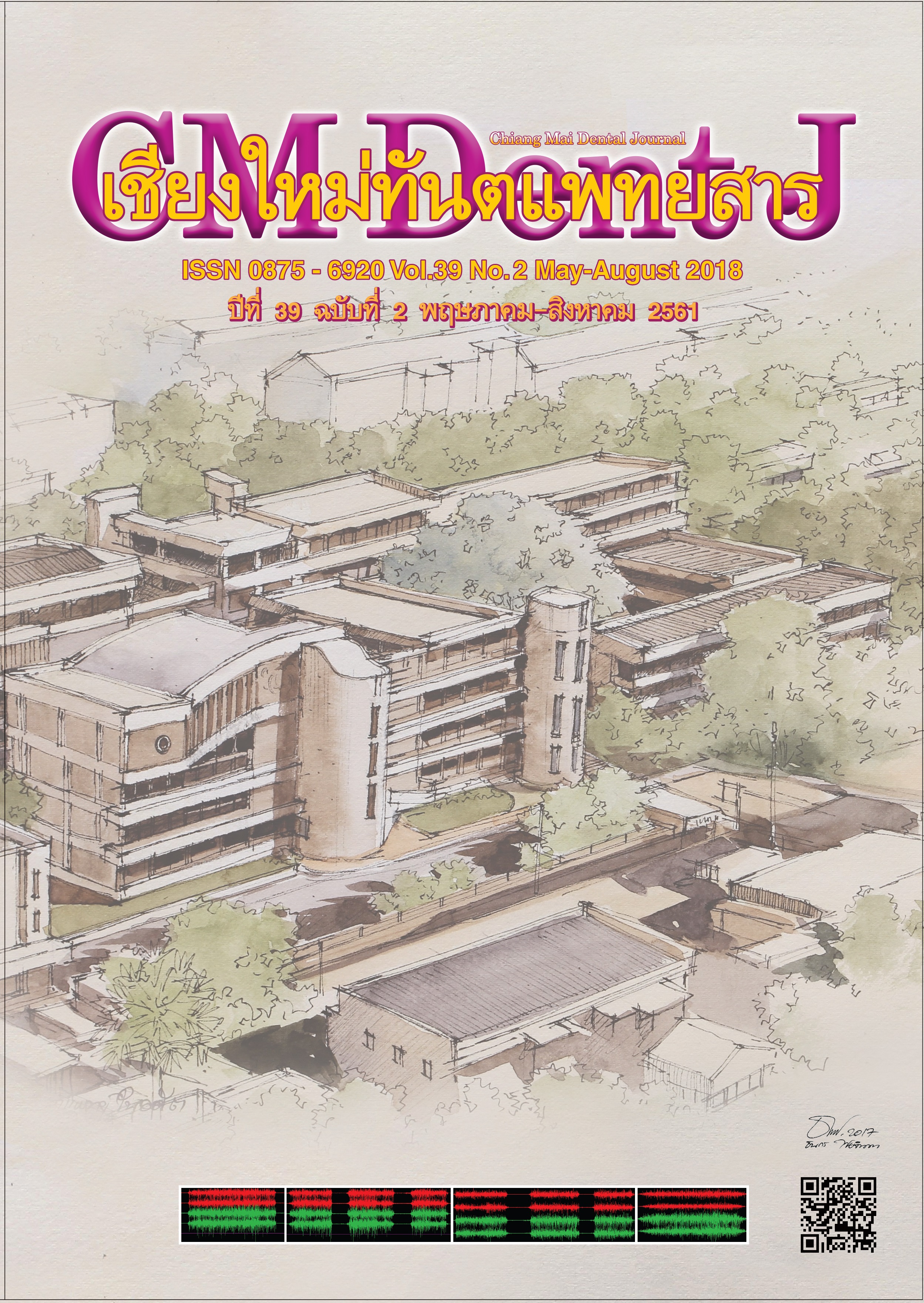A 3 Years Retrospective Analysis of Survival Rate of Thai Dental Implant (PW PLUS®) in 23 Patients
Main Article Content
Abstract
Objective: The purpose of this study was to evaluate survival rate of Thai dental implant (PW PLUS®) which had been installed and restored in department of advanced general dentistry, Mahidol University (3-year results, from 2012-2015).
Materials and Methods: A retrospective documents review was conducted on 23 consecutive patients, 38 implants. Each patient had at least one implant placed in the maxilla and/or mandible in advanced general dentistry clinic, Mahidol University. These patients were recalled for examined in follow up visit. Patients were examined a clinical and radiographic assessment. All failed implant was recorded. Descriptive statistical analysis, implant survival were evaluated using Kaplan Meier analysis.
Results: 23 patients (11 were male and 12 were female) were included in this study. About 38 implants were placed, 1 implant failed due to fixture fracture, while 37 implant still in functioned. Biologic and mechanical complications were observed, screw loosening was 29.73% (11). A cumulative survival rate of 94.4% (37) was found after 3 years.
Conclusion: On the basis of this retrospective analysis it might be concluded that 3-year survival rate of Thai dental implant (PW PLUS®) was similar to others. Mechanical complications such as screw loosening appeared in high percentage.
Article Details
References
Branemark PI. Osseointegration and its experimental background. J Prosthet Dent. 1983;50(3):399-410.
Branemark PI, Hansson BO, Adell R, Breine U, Lindstrom J, Hallen O, et al. Osseointegrated implants in the treatment of the edentulous jaw. Experience from a 10-year period. Scand J Plast Reconstr Surg Suppl. 1977;16:1-132.
Attard NJ, Zarb GA. Long-term treatment outcomes in edentulous patients with implant-fixed prostheses: the Toronto study. Int J Prosthodont. 2004;17(4):417-24.
Adell R, Lekholm U, Rockler B, Branemark PI. A 15-year study of osseointegrated implants in the treatment of the edentulous jaw. Int J Oral Surg. 1981;10(6):387-416.
ten Bruggenkate CM, van der Kwast WA, Oosterbeek HS. Success criteria in oral implantology. A review of the literature. Int J Oral Implantol. 1990;7(1):45-51.
Cochran DL, Buser D, ten Bruggenkate CM, Weingart D, Taylor TM, Bernard JP, et al. The use of reduced healing times on ITI implants with a sandblasted and acid-etched (SLA) surface: early results from clinical trials on ITI SLA implants. Clin Oral Implants Res. 2002;13(2):144-53.
Albrektsson T, Zarb G, Worthington P, Eriksson AR. The long-term efficacy of currently used dental implants: a review and proposed criteria of success. Int J Oral Maxillofac Implants. 1986;1(1):11-25.
Misch CE, Perel ML, Wang HL, Sammartino G, Galindo-Moreno P, Trisi P, et al. Implant success, survival, and failure: the International Congress of Oral Implantologists (ICOI) Pisa Consensus Conference. Implant Dent. 2008;17(1):5-15.
Suzuki JB, Terracciano-Mortilla LD, Misch CE. Dental implants prothetics. 2, editor. Missouri: Mosby; 2014.
Albrektsson T, Branemark PI, Hansson HA, Lindstrom J. Osseointegrated titanium implants. Requirements for ensuring a long-lasting, direct bone-to-implant anchorage in man. Acta Orthop Scand. 1981;52(2):155-70.
Gupta A, Dhanraj M, Sivagami G. Status of surface treatment in endosseous implant: a literary overview. Indian J Dent Res. 2010;21(3):433-8.
Buser D, Janner SF, Wittneben JG, Bragger U, Ramseier CA, Salvi GE. 10-year survival and success rates of 511 titanium implants with a sandblasted and acid-etched surface: a retrospective study in 303 partially edentulous patients. Clin Implant Dent Relat Res. 2012;14(6):839-51.
Lee DW, Choi YS, Park KH, Kim CS, Moon IS. Effect of microthread on the maintenance of marginal bone level: a 3-year prospective study. Clin Oral Implants Res. 2007;18(4):465-70.
Hansson S. The implant neck: smooth or provided with retention elements. A biomechanical approach. Clin Oral Implants Res. 1999;10(5):394-405.
Kang YI, Lee DW, Park KH, Moon IS. Effect of thread size on the implant neck area: preliminary results at 1 year of function. Clin Oral Implants Res. 2012;23(10):1147-51.
Khongkhunthian P, Khongkhunthian S, Weerawatprachya W, Pongpat K, Aunmeungtong W. Comparative study of torque resistance and microgaps between a combined Octatorx-cone connection and an internal hexagon implant-abutment connection. J Prosthet Dent. 2015;113(5):420-4.
Munchukangwan C, Sae-Lee D, Suwannarong W, Khongkankong W, Limmonthol S, Puasiri S, et al. Clinical comparison between PW-Plus and Osstem Implant System Supported Single Crown in the Posterior Mandible: A 1-Year Pilot Study. Graduate Research Conference; Khon Kean University2014.
Ainamo J, Bay I. Problems and proposals for recording gingivitis and plaque. Int Dent J. 1975;25(4):229-35.
Karoussis IK, Salvi GE, Heitz-Mayfield LJ, Bragger U, Hammerle CH, Lang NP. Long-term implant prognosis in patients with and without a history of chronic periodontitis: a 10-year prospective cohort study of the ITI Dental Implant System. Clin Oral Implants Res. 2003;14(3):329-39.
Zarb GA, Albrektsson T. Consensus report: towards optimized treatment outcomes for dental implants. J Prosthet Dent. 1998;80(6):641.
Roos J, Sennerby L, Lekholm U, Jemt T, Grondahl K, Albrektsson T. A qualitative and quantitative method for evaluating implant success: a 5-year retrospective analysis of the Branemark implant. Int J Oral Maxillofac Implants. 1997;12(4):504-14.
Moraschini V, Poubel LA, Ferreira VF, Barboza Edos S. Evaluation of survival and success rates of dental implants reported in longitudinal studies with a follow-up period of at least 10 years: a systematic review. Int J Oral Maxillofac Surg. 2015;44(3):377-88.
Rangert B, Krogh PH, Langer B, Van Roekel N. Bending overload and implant fracture: a retrospective clinical analysis. Int J Oral Maxillofac Implants. 1995;10(3):326-34.
Piattelli A, Scarano A, Piattelli M, Vaia E, Matarasso S. Hollow implants retrieved for fracture: a light and scanning electron microscope analysis of 4 cases. J Periodontol. 1998;69(2):185-9.
Simonis P, Dufour T, Tenenbaum H. Long-term implant survival and success: a 10-16-year follow-up of non-submerged dental implants. Clin Oral Implants Res. 2010;21(7):772-7.
Karoussis IK, Muller S, Salvi GE, Heitz-Mayfield LJ, Bragger U, Lang NP. Association between periodontal and peri-implant conditions: a 10-year prospective study. Clin Oral Implants Res. 2004;15(1):1-7.
Siamos G, Winkler S, Boberick KG. Relationship between implant preload and screw loosening on implant-supported prostheses. J Oral Implantol. 2002;28(2):67-73.


